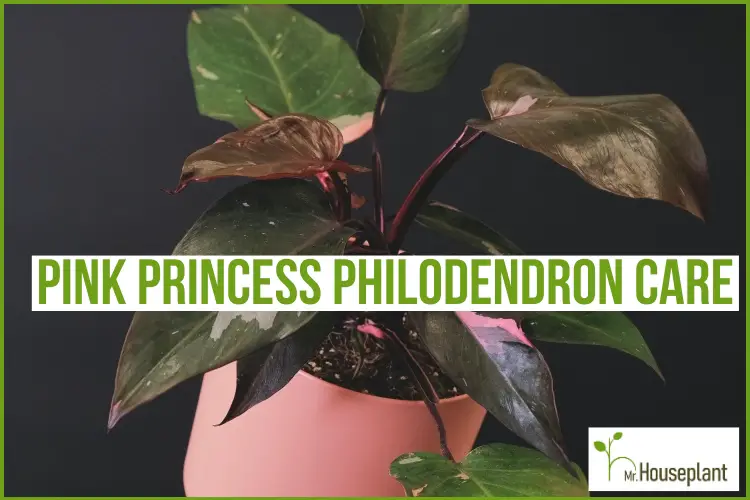
Are you worried because your Pink Princess Philodendron leaves aren’t thriving? Don’t worry, after reading this post you will be completely equipped with all the necessary knowledge to care for Pink Princess Philodendron.
| Botanical Name: | Philodendron erubescens ‘pink princess’ |
| Common Name: | Pink Princess Philodendron |
| Light: | medium light (1,000+ lux (100+ FC)) |
| Watering: | when the top 2″ are dry/once the top half of the soil is dry |
| Soil: | well-draining mix |
| Repotting: | Once a year |
| Temperature: | 70° F to 90°F (21°C to 32°C) |
| Humidity: | over 60%, but it adapts well to lower humidity |
| Toxicity for Pets: | Yes, it causes swelling and irritation of the oral cavity, difficulty swallowing, excessive drooling, and vomiting |
| Toxicity for Humans: | Yes, it causes irritation to the skin and lips, and breathing difficulties in severe cases |
| Propagation: |
|
| Pruning: | Prune dead or diseased growth or when you want the plant to branch out |
About the ‘Pink Princess’ (Origin & Background)
Philodendron Pink Princess is a cultivar of Philodendron Erubescens, and it is famous for its elegant heart-shaped leaves with pink and green variegation, hence the name Pink Princess.
The Philodendron genus is large and very diverse, comprising around 500 species native to South America. The name of the genus is derived from a combination of two Greek words, Philo, which means ‘’to love’’ and dendron which means ‘’tree’’. Philodendron plants are ‘’tree lovers’’ since they love to climb up the trees in their natural habitat.
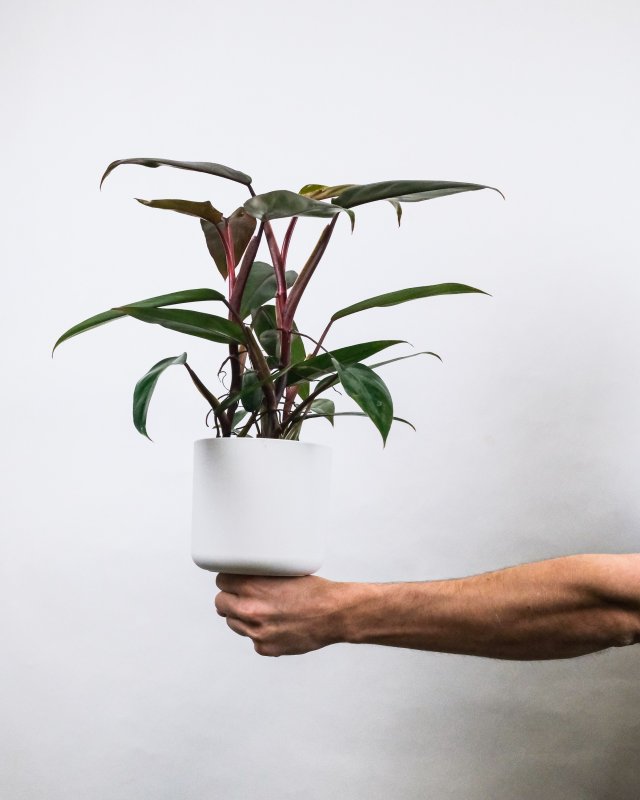
Philodendron erubescens was named after its vibrant red stems
Pink Princess Philodendron Care & Growing Instructions
Pink Princess philodendron care isn’t so difficult, despite the plant’s posh status and high price. If you follow all the advice in this post, you will be able to have a healthy, gorgeous, and lush Pink Philodendron. Philodendron that’s famous for its pink variegated leaves.
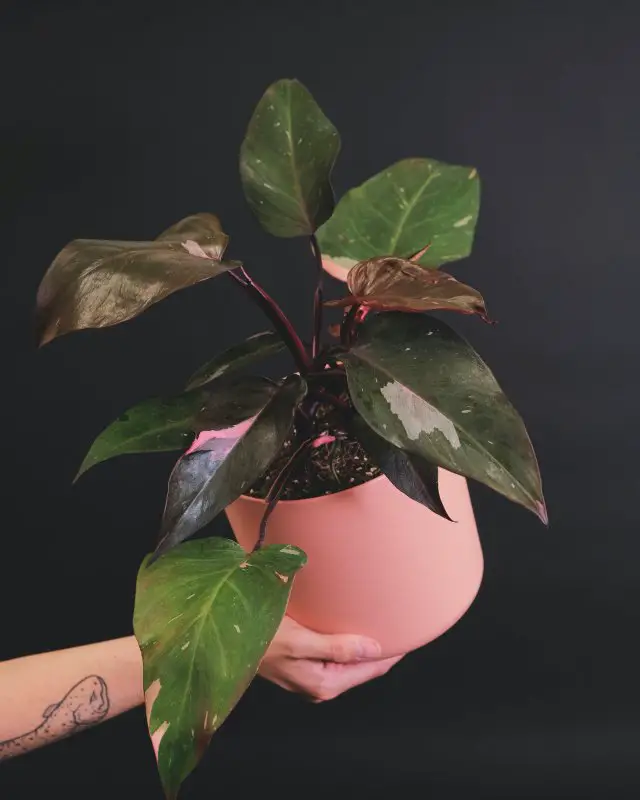
Beautiful Philodendron ‘Pink Princess’ that will beautify your indoor garden
Light Requirements
| Minimal amount of light: | 1,000 lux (100 FC) |
| Optimal amount of light: | 2,500+ lux (250+ FC) |
| Direct sun tolerance: | 2-3 hours |
| Category: | Medium light |
Pink Princess philodendron thrives in medium indirect light. The minimal amount of light for a Pink philodendron is 1,000 lux (100 FC), and the optimal amount is over 2,500 lux (250 FC). Like many tropical plants, it can tolerate a maximum of 2-3 hours of weak, morning, or late afternoon direct sunlight each day.
It’s important to find a sweet spot when it comes to light requirements for this plant. If it doesn’t get enough light, the vibrant pink variegation will start to fade and the Erubescens ‘pink princess’ will start producing solid green leaves. An east or west facing window is a great spot for your beautiful Pink Princess, as it will provide just the right amount of light. If you’re not quite sure what is indirect light for plants, take a look at this blog post.
Water Needs
You should water your Pink Philodendron when the top 2 inches of soil dry out, for smaller pots, and the top half, for larger pots. The actual watering frequency will depend on many factors, such as light, humidity, pot size, etc. Since Philodendron ‘Pink Princess’ doesn’t like overly moist soil, make sure to check if the top half is dry before watering, and keep it in a pot with drainage holes.
Ideal Potting Soil for Growing Philodendron Pink Princess
The ideal potting soil for growing the Philodendron Pink Princess plant should consist of:
- 2 parts of all-purpose potting soil mix
- 1 part bark
- 1 part perlite
Pink Princess loves well-draining soil, that’s why it’s best to mix it with amendments like perlite, orchid bark, vermiculite, or other amendments. The store-bought potting soil retains too much water which can lead to root rot. It is beneficial to add amendments because they prevent the soil from becoming soggy. They also have macro-pores that hold oxygen. A plant rich in oxygen is more resilient and capable of absorbing all the nutrients.
Humidity Needs
Pink Princess philodendron prefers higher humidity levels, over 60%, like some of its tropical cousins. However, like most indoor plants it has no issues with adapting to lower humidity. Even if you have low humidity levels in the area where you put your Pink Princess philodendron, it will still flourish.
Temperature Requirements
The best temperature range for the philodendron ‘Pink Princess’ is from 70° F to 90°F (21°C to 32°C). The quality of the plant will start to decline if the temperatures constantly go below 65°F (18°C) or higher than 95°F (35°C). Pink Princess Philodendron is sensitive to cold and extreme heat, so make sure to stay within the best temperature range to ensure it’s grown optimally.
Climbing and Support
Since Pink Princess philodendrons are vining plants that like to climb, it’s important to offer the right support. Philodendrons that climb, if given proper light, will grow bigger leaves than the ones that don’t have climbing support. You can opt for a trellis or moss pole to give your Philodendron the support it needs to grow big and tall.
Fertilizing
If you repot your philodendron Pink Princess plant annually, there’s no need to fertilize it, because fresh soil will provide it with all the nutrients. However, if you wish to fertilize your Philodendron plant, you can do it, just follow the advice on the fertilizer packaging. It’s important to use a high nitrogen liquid fertilizer, like the Sill fertilizer, which has an excellent N-P-K ratio od 9-3-6.
The rule to fertilize your plants only in the growing season (spring or summer) doesn’t apply to houseplants, which means that you can fertilize them even in winter, as long as they are actively growing. Avoid using fertilizer when the plant is not growing actively. It won’t be able to use all the nutrients which will accumulate in the container and possibly lead to burned roots.
Repotting your Philodendron Pink Princess
To repot your Pink Princess Philodendron plant you should take the following steps:
- Prepare a pot that is one size bigger and fill it up to one-third with fresh soil
- Take out your Pink Princess carefully
- Loosen the rootball and check to see if the roots are healthy
- If you notice that the roots are mushy or rotten, prune them
- Place your plant into its new pot
- Fill the pot with soil and lightly press it around the plant
- Water your Pink Princess and let it rest
It’s best to repot your plant once a year, so it can get the necessary nutrients from fresh soil and enough oxygen.
There are two ways to repot your plant:
- potting up
- or full repotting.
If you choose to pot up, you should move your beautiful Pink Princess philodendron plant together with its root mass and soil into a new pot. Losen the rootball. Then you should fill up the pot with soil.
If you go for full repotting, you should remove the soil completely, and prune the roots that are rotten or diseased.
While full repotting is in general better for your plant, it’s also slightly risky because you can kill your plant by accident. If you’re a beginner, stick to potting up, and if you’re experienced, go for full repotting.
Toxicity For Humans
According to California Poison Control System, the Pink Princess philodendron plant is toxic to humans. The sap of Pink Princess has insoluble calcium oxalate crystals that can cause irritation to the skin and lips, and in severe cases, they can cause breathing difficulties by inducing throat swelling.
Toxicity For Pets
Pink Princess philodendron is toxic to pets, according to the American Society for Prevention of Cruelty to Animals (ASPCA). It can cause swelling and irritation of the oral cavity, as well as certain symptoms such as difficulty swallowing, excessive drooling, and vomiting.
Pruning
You should prune your Pink Princess philodendron plant if you notice any dead or diseased parts on it. If your plant is healthy, there is no need to prune it. You can prune a healthy plant though if you want to achieve particular aesthetics and make your plant bushier. Cut off the top of the stem, and your Princess philodendron will branch out below the cut.
Pink Princess Propagation
There are several methods for Pink Princess philodendron propagation, listed below:
- Stem cuttings (tip cuttings) in water or soil
- Division
- Air Layering
You can propagate your Pink Princess throughout the year, as long as there is enough light and it’s warm enough. Since the Pink Princess philodendron is kept as an indoor plant, and it’s always warm enough in your home, you can propagate your plant whenever you want.
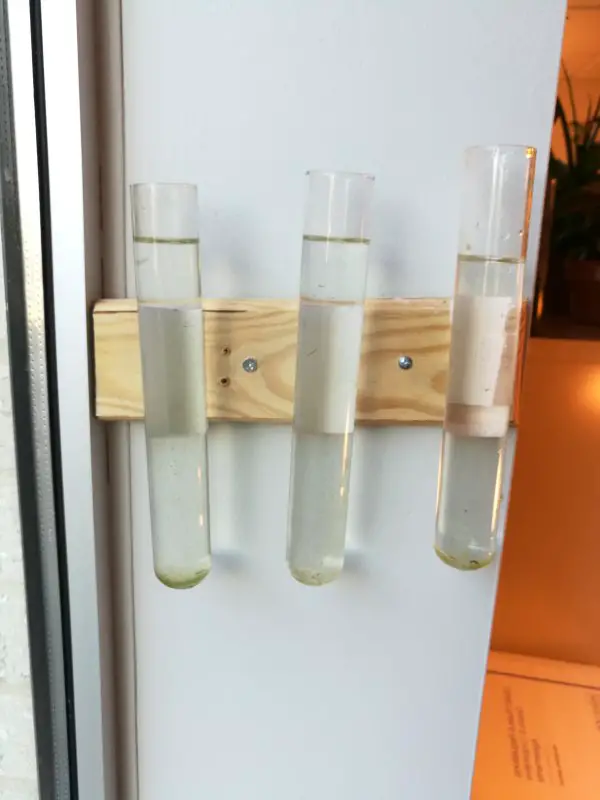
The vials used for stem cuttings in the water propagation method
To propagate your plant from a stem cutting (tip cutting) in the water you should:
- Sterilize your scissors or shears with rubbing alcohol
- Locate a growth node on the plant and cut the stem below it
- Your stem cutting should have at least three nodes, which means that you should cut the stem below the third node
- Place the stem cutting in water, making sure that the bottom 2 nodes are in water
- Place the propagation vessel with the cutting in bright indirect light
- Change the water every 5-7 days to prevent bacteria buildup and to provide oxygen for the roots
- After 1-4 weeks the stem cutting will start to grow roots
- Your stem cutting is now ready to be planted in the new container
Most Common Philodendron Pink Princes Pests
The most common Pink Princess philodendron pests are aphids and fungus gnats. Infestation with aphids may go undetected until honeydew, the aphid’s sticky excretion is seen. Aphids are generally found on the underside of leaves. They are pear-shaped and soft-bodied with colors ranging from light green to dark brown. The easiest way to get rid of aphids is to remove them manually, using a strong jet of water, as soon as you spot them, in the early stages of the infestation.
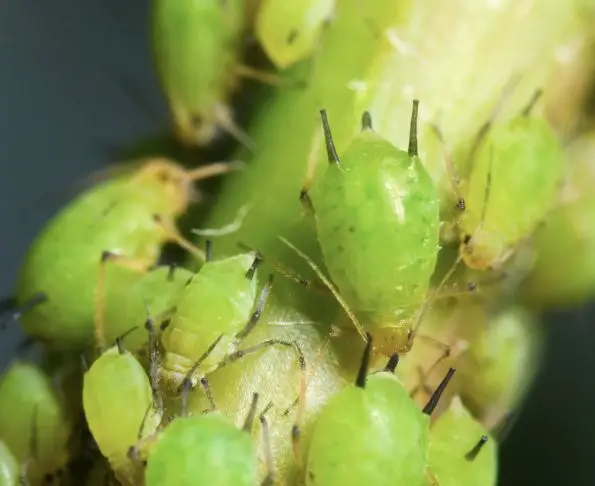
Light green aphids on a grown plant
Fungus gnats are small black flies that feed on decaying organic matter in the soil. Although they usually feed on decaying organic matter, if they run out of it, they will start to feed on roots. In general, they won’t cause damage to your Pink Princess philodendron, they are just very annoying. Luckily, there are many different ways to get rid of fungus gnats, and you can try them to see which one works best for you.
FAQs About Philodendron Pink Princess
Is the Pink Princess Philodendron rare?
Yes, the Pink Princess philodendron is a rare plant, since it’s a cultivar that was designed to have eye-catching pink variegation. It’s not easy to maintain this variegation and the propagation through tissue culture is quite time-consuming.
Is the Pink Congo Philodendron the Same as the Pink Princess Philodendron?
No, the Pink Congo Philodendron is not the same as the Pink Princess Philodendron. Pink Congo is a houseplant scam that outraged many plant lovers. It has completely pink leaves on top. These leaves are chemically treated and they return to solid green after some time. You need to know that plants with white or pink variegation need to have some green color on their leaves because the green color indicates the presence of chlorophyll. Plants need chlorophyll to perform photosynthesis. If the leaves are completely pink, there’s a lack of chlorophyll and no photosynthesis, which means that the plant cannot survive.
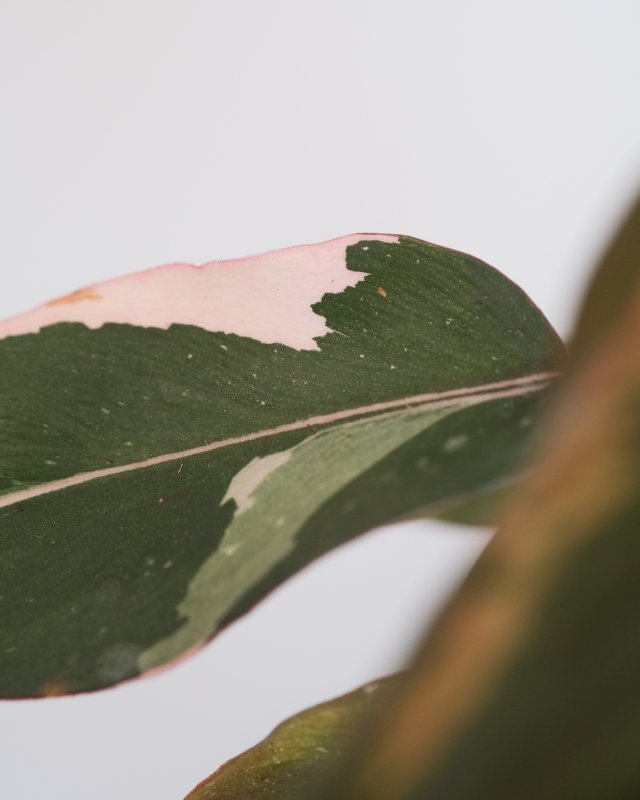
Pink green variegated Princess philodendron leaf - all variegated plants must have some green color on the foliage
Is the Pink Princess Easy to Care for?
Yes, Pink Princess Philodendron is easy to care for. If you provide it with bright light and a proper potting mix and follow all the tips in this Pink Princess philodendron care guide, you will be a happy owner of a gorgeous and healthy houseplant.
Can you Grow a ‘Pink Princess’ from Seed?
No, you can’t grow a philodendron ‘Pink Princess’ from seed. If you try to do so, you won’t get the desired result, since the variegation is caused by a mutation that cannot be replicated through seeds. Your best bet is to propagate your Princess philodendron using the stem-cutting method.
Why Is the Philodendron Pink Princess so Expensive?
The Philodendron Pink Princess is so expensive because it’s rare and the growers can’t guarantee that the variegation will be well-balanced. A combination of low supply, the rarity of the plant, and difficulty in obtaining a balanced variation is the reason for the high price of Pink Princess Philodendron.
How do Pink Princesses Get Big Leaves?
If you want big lush leaves on Pink Princess Philodendron, you should ensure that it’s getting sufficient light every day and that it’s able to climb. A climbing philodendron can grow bigger leaves than a philodendron that has no conditions to climb. A good liquid fertilizer should also cover all the nutrients that your Philodendron ‘Pink Princess’ plant needs.
Why is My Plant Losing its Pink Variegation?
Pink Princess Philodendrons will lose the pink variegation if there is a lack of light. If it lacks proper light, it will start developing more solid green leaves since they contain more chlorophyll which means that they are more efficient at photosynthesis. The key to preventing this is to always ensure that your houseplant is getting enough light.
How to Tell if a Pink Princess Philodendron has Reverted?
You can tell that your Pink Philodendron has reverted if the pink leaves turn burgundy, or if it starts developing more solid green, non-variegated leaves. The good news is that it’s possible to do something about it and keep the balanced variegation. By increasing the amount of light you are encouraging the plant to produce more varegation.
How do You Encourage Variegation on Pink Princess?
You can encourage Pink Princess philodendron variegation by growing it under adequate light. If you can’t provide it with enough light, you can use the best cheap LED grow lights. You should also remove leaves that have turned burgundy and those that are solid green. Prune your Pink Princess Philodendron stem to the last variegated leaf in order to promote new growth. By doing this, you’re improving the odds of getting new green leaves that are variegated.
Why is My Plant Getting Leggy?
Your plant is getting leggy because it’s trying to reach the light, this phenomenon is called phototropism. When indoor plants don’t have enough light, they tend to stretch and lean towards the source of light, which elongates the stems and makes them leggy. This issue can be resolved by providing your Pink Princess philodendron with proper light that is spread evenly around the houseplant. A good way to ensure that the light is spread evenly is to use a plant shelf with grow lights.
Why is Pink Princess Slow Growing?
Your Pink Princess is growing slowly due to one of the following reasons:
- insufficient light
- lack of nutrients
- compacted soil
- not enough space in the pot
The best way to promote new growth is to give your plant bright indirect light, repot if you haven’t repotted recently, and fertilize. Use a high-quality liquid fertilizer such as the Sill fertilizer. Read the usage instructions on the packaging, since it’s possible to overfertilize.
Conclusion
Pink Princess is rare but easy-to-care Philodendron. Grow Pink Princess according to the care tips from this article and you will enjoy variegated pink leaves which will beautify your home.
Yours Truly,


Related Posts
Sansevieria Black Gold (Snake Plant Care GUIDE!)
Spathiphyllum Sensation (FULLY Explained!)
Alocasia Stingray Care